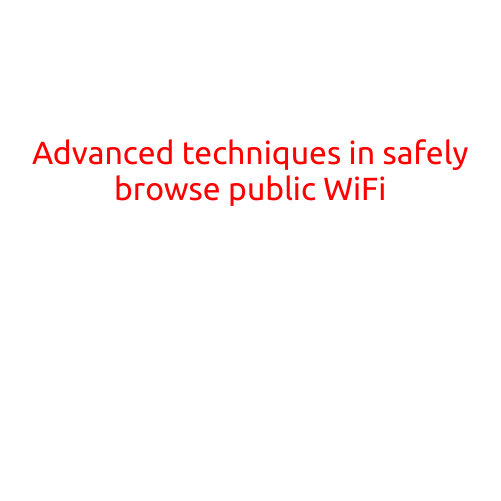
Advanced Techniques in Safely Browsing Public WiFi
With the increasing availability of public Wi-Fi hotspots, more and more people are relying on these networks to stay connected while on-the-go. However, public WiFi networks also pose significant security risks, as they are often unsecured or poorly maintained, leaving your personal data vulnerable to hackers and cybercriminals. In this article, we will dive into advanced techniques to help you safely browse public WiFi networks and minimize the risk of data breaches.
1. Use a Virtual Private Network (VPN)
One of the most effective ways to securely connect to a public WiFi network is to use a Virtual Private Network (VPN). A VPN creates a secure, encrypted connection between your device and the VPN server, preventing anyone from intercepting your internet traffic. When you use a VPN, your internet activity is routed through the VPN server, making it difficult for hackers to snoop on your data.
2. Enable Two-Factor Authentication (2FA)
Two-Factor Authentication (2FA) is an additional layer of security that requires you to provide a second form of verification, such as a code sent to your phone or a biometric scan, in addition to your password. When you enable 2FA on your device, it makes it much harder for hackers to gain access to your account, even if they have your password.
3. Use a Strong and Unique Password
Choosing a strong and unique password for your device and any online accounts you access while connected to public WiFi is crucial. Avoid using easily guessable passwords, such as your name, birthdate, or common words. Instead, use a password manager to generate and store complex, unique passwords for each account.
4. Avoid Conducting Sensitive Transactions
While it may be tempting to check your bank account or make online purchases while connected to public WiFi, it’s best to avoid conducting sensitive transactions altogether. Hackers can potentially intercept your sensitive information, such as credit card numbers and passwords, while you’re connected to public WiFi.
5. Keep Your Device and Software Up to Date
Ensuring your device and software are up to date with the latest security patches and updates is essential to protecting your data while connected to public WiFi. Outdated software can leave your device vulnerable to security vulnerabilities, making it easier for hackers to breach your device.
6. Monitor Your Device’s Network Activity
Regularly monitor your device’s network activity to detect any suspicious activity. Check your device’s settings to monitor your internet traffic and detect any unexpected connections or data transfers.
7. Avoid Clicking on Suspicious Links
When browsing public WiFi, be cautious when clicking on links or opening emails from unknown senders. Hackers often use public WiFi networks to spread malware and phish for sensitive information.
8. Use a Firewall
A firewall acts as a barrier between your device and the internet, blocking unauthorized access to your device and preventing hackers from sending malicious traffic to your device.
9. Limit Your Exposure
Limit your exposure to public WiFi by only accessing necessary websites and services, and avoid conducting sensitive activities, such as online banking or shopping.
10. Consider Using a Mobile Hotspot
If possible, consider using a mobile hotspot to connect your device to the internet instead of a public WiFi network. Mobile hotspots are often more secure and less vulnerable to hacking.
By following these advanced techniques, you can safely browse public WiFi networks and minimize the risk of data breaches. Remember to always prioritize your online security and take the necessary steps to protect your personal information.





